How To Lower Your Cholesterol with Exercise
Regular exercise can improve your cholesterol levels, lowering your LDL cholesterol and increasing your HDL cholesterol for improved heart health. Cholesterol is a lipid that circulates within our blood. While HDL cholesterol helps in the transport of lipids to the liver for disposal, LDL cholesterol can build up in the wall of our arteries and negatively affect our heart health. Research has shown that moderate-intensity aerobic exercise can increase good HDL cholesterol, high-intensity aerobic exercise can lower LDL and triglyceride levels, and moderate-intensity resistance workouts are effective in lowering cholesterol.
What is Cholesterol?
Cholesterol is a lipid, a fatty substance that circulates within our blood. The body uses cholesterol to help build cells, make vitamins and hormones, and digest some fatty foods. There are two types of cholesterol: LDL, or low-density lipoprotein and HDL, high-density lipoprotein.
HDL Cholesterol: known as the “good” cholesterol, HDL cholesterol transports lipids back to the liver for recycling and disposal. High levels of HDL cholesterol are an indicator of a healthy cardiovascular system.
LDL Cholesterol: known as the “bad” cholesterol, LDL cholesterol can build up in the walls of our arteries, causing them to narrow and increasing the risk of cardiovascular disease. High levels of LDL cholesterol indicate surplus lipids in the blood, which can increase the risk of cardiovascular complications.
Nearly 38% of American adults have high LDL cholesterol and are therefore at heightened risk for adverse cardiovascular events. A great way to reduce bad LDL cholesterol and increase good HDL cholesterol is through exercise.
How Exercise Can Lower Cholesterol
Regular exercise can improve your cholesterol levels, lowering your LDL cholesterol and increasing your HDL cholesterol for improved heart health. Exercise is thought to improve the body’s ability to utilize fats rather than carbohydrates for energy, effectively lowering levels of fats including cholesterol in the bloodstream. Exercise enhances the ability of skeletal muscles to utilize lipids as opposed to glycogen for energy, lowering blood lipid levels.
Exercise changes the size of the LDL particle size to larger particles that do not carry the same risk of clogging arteries as smaller, denser LDL particles do. Exercise also enhances the transport of cholesterol from the bloodstream to the liver where it is filtered out of the body. Additionally, exercise can help reduce the absorption of cholesterol from the small intestine into the bloodstream.
Experts recommend that individuals engage in both aerobic exercise and resistance training to improve cholesterol levels. Numerous research studies support the use of aerobic exercise and resistance training to address high cholesterol and improve a patient’s overall cardiovascular health. One study showed that walking one hour a day five times a week over a 24-week period increased levels of HDL, while another study revealed that HDL levels increased after regular high-intensity strength training that took place 3 times a week over a 10-week period.
A 2014 study noted that women who underwent supervised resistance training three times a week over 14 weeks saw amounts of total and LDL cholesterol in the body reduce. A meta-analysis of 51 interventions involving 12 weeks or more of aerobic exercise reported that on average, HDL cholesterol increased by 4.6%, triglyceride levels fell by 3.7%, and LDL cholesterol fell by 5%. In the study, the HDL: LDL ratio improved.
Moderate-intensity cardio involves walking briskly, heavy cleaning like vacuuming, biking, playing doubles tennis, jumping on a trampoline, kayaking, yard work, recreational swimming, and dancing. Experts recommend 150 minutes of moderate-intensity cardio each week, or 30 minutes, 5 times a week.
High-intensity cardio includes hiking, walking, or jogging at a quick pace, shoveling snow, carrying heavy loads, biking fast or up steep hills, karate, playing soccer, basketball, football, or singles tennis, swimming laps, or jumping rope. It is recommended to engage in 75 minutes of high-intensity cardio a week, or 25 minutes, three times a week. Resistance training involves the use of dumbbells, weight machines, or body weight to strengthen and build muscle. It is recommended to engage in strength training at least twice a week.
Per the research, moderate-intensity aerobic exercise increases good HDL cholesterol that helps remove LDL from the body. High-intensity aerobic exercise lowers LDL and triglyceride levels. When it comes to resistance training, research shows that moderate-intensity workouts appear to have a stronger effect on lowering cholesterol than high-intensity resistance training workouts.
Are you battling high LDL cholesterol? Exercise is a great way to address your cholesterol levels and improve your health! Work with a physical therapist today to start your exercise journey!
